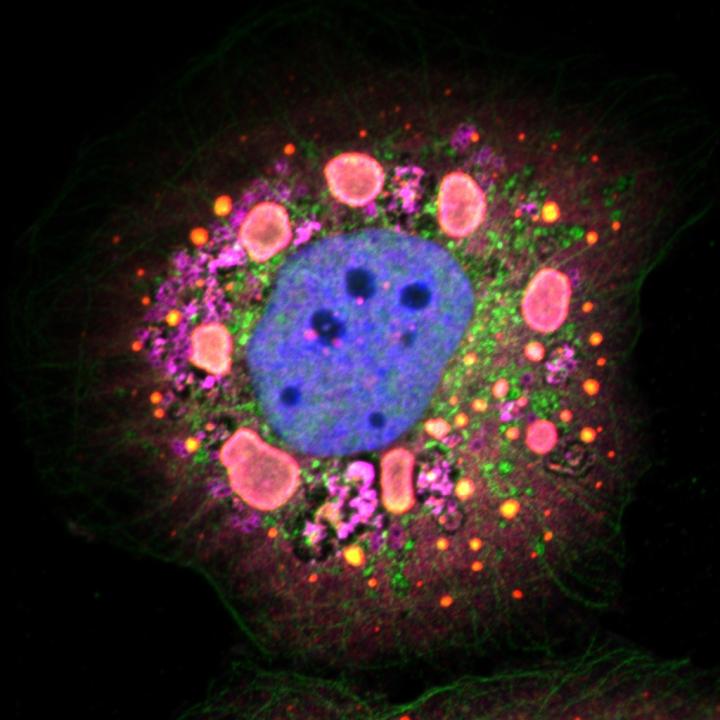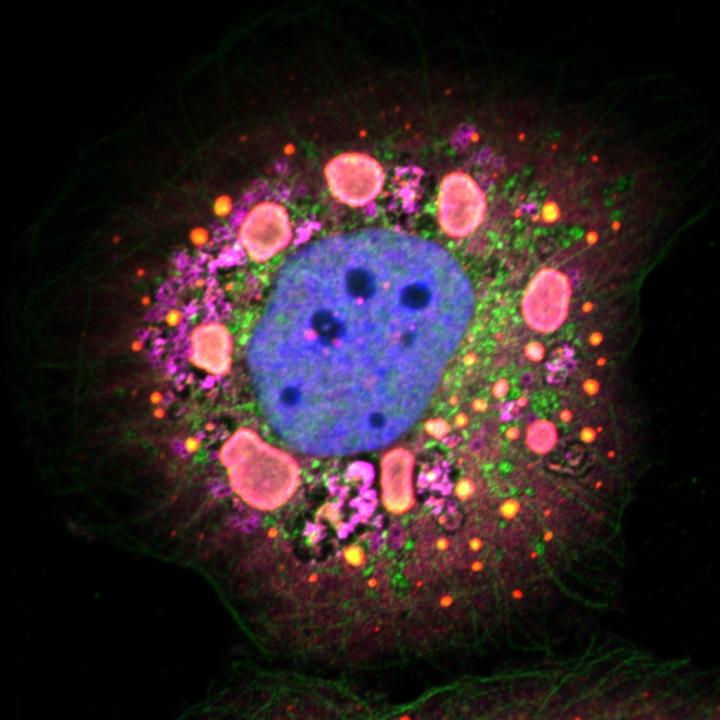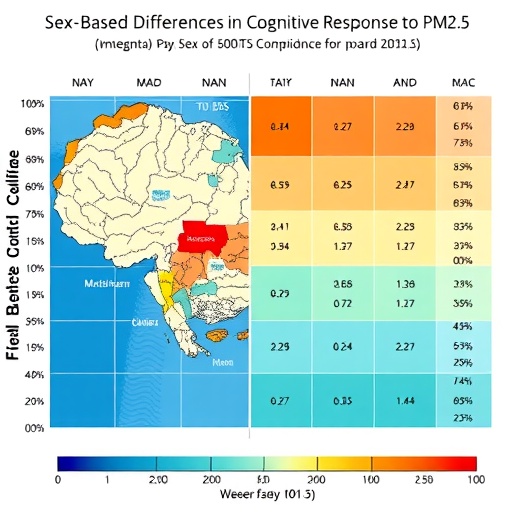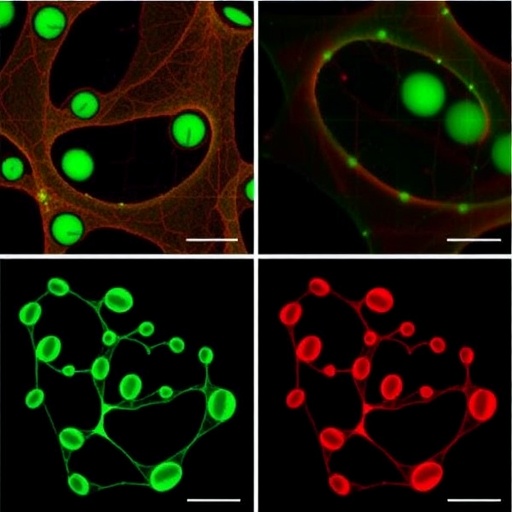
Credit: Nature Microbiology/Dermody Lab
PITTSBURGH, March 12, 2018 – Viruses are intracellular parasites that cause disease by infecting the cells in the body and, in a study published today in Nature Microbiology, researchers at Children's Hospital of Pittsburgh of UPMC and the University of Pittsburgh School of Medicine showed how a common virus hijacks a host cell's protein to help assemble new viruses before they are released. The findings increase our understanding of how viruses reproduce in the body and could lead to new therapeutics.
While most research into viral infections has focused on mechanisms viruses use to enter cells, less is known about the late steps in infection. The new findings were identified in reovirus, a common virus that is normally harmless but has recently been implicated as a potential cause of celiac disease.
"Our work provides compelling evidence that reoviruses, and perhaps additional distantly related viruses, require a specialized protein-folding machine expressed in cells to replicate," said Terence Dermody, M.D., chair of the Department of Pediatrics at Pitt's School of Medicine, physician-in-chief and scientific director at Children's Hospital, and the senior author on the study. "This is a pretty remarkable finding because viruses are in large part made of complex protein building blocks and we know little about how these blocks are assembled."
Folding proteins in the right way is crucial to their function. "Think of an unfolded protein like a plain sheet of paper: Rather unremarkable by itself, but capable of performing sophisticated functions when folded in a certain way, such as into an airplane. Similarly, proteins need to fold into specific shapes to work correctly," said Jonathan Knowlton, the first author of the study and a researcher in Dermody's lab.
By screening a large number of proteins in lab-grown cells, the researchers discovered that reovirus hijacks a chaperone protein – a machine that folds other proteins – called TRiC, that is present in every cell. In the case of reovirus, TRiC folds a major component of the protein shell that forms the outer coat of the virus, which is required for it to exit the cell and infect other healthy cells. When TRiC is disrupted, the outer coat cannot form and the cycle of viral replication is broken.
This study sheds light on the poorly understood process by which viral proteins fold and assemble to form new particles. The researchers are now studying whether other viruses use this pathway to reproduce, identifying the exact steps in the folding process enabled by TRiC and looking for molecules that inhibit the process, which could be developed as therapies.
In addition, this research contributes to an understanding of how the protein-folding machinery functions inside cells and may explain the manifestations of protein-misfolding diseases, such as Alzheimer's and Huntington's.
###
Additional authors on the study are Paula Zamora, from Children's Hospital and Pitt; Isabel Fernández De Castro, Ph.D., and Cristina Risco, Ph.D., from Spanish National Research Council; Alison Ashbrook, Ph.D., and Joshua Bauer, Ph.D., from Vanderbilt University School of Medicine; Daniel Gestaut, Ph.D., and Judith Frydman, Ph.D., from Stanford University; and J. Craig Forrest, Ph.D., from University of Arkansas for Medical Sciences.
This research was supported in part by National Institutes of Health awards AI032539, AI122563, GM007347 and UL1TR000445, and the Vanderbilt Lamb Center for Pediatric Research.
About Children's Hospital of Pittsburgh of UPMC
Regionally, nationally, and globally, Children's Hospital of Pittsburgh of UPMC is a leader in the treatment of childhood conditions and diseases, a pioneer in the development of new and improved therapies, and a top educator of the next generation of pediatricians and pediatric subspecialists. Children's Hospital has fulfilled this mission since its founding in 1890. Children's is named consistently to several elite lists of pediatric hospitals, including ranking 10th among children's hospitals and schools of medicine (FY 2016) in funding for pediatric research provided by the National Institutes of Health, and is one of 10 pediatric hospitals in the United States named to the U.S. News & World Report Honor Roll of America's "Best Children's Hospitals" for 2017-2018.
About the University of Pittsburgh School of Medicine
As one of the nation's leading academic centers for biomedical research, the University of Pittsburgh School of Medicine integrates advanced technology with basic science across a broad range of disciplines in a continuous quest to harness the power of new knowledge and improve the human condition. Driven mainly by the School of Medicine and its affiliates, Pitt has ranked among the top 10 recipients of funding from the National Institutes of Health since 1998. In rankings recently released by the National Science Foundation, Pitt ranked fifth among all American universities in total federal science and engineering research and development support.
Likewise, the School of Medicine is equally committed to advancing the quality and strength of its medical and graduate education programs, for which it is recognized as an innovative leader, and to training highly skilled, compassionate clinicians and creative scientists well-equipped to engage in world-class research. The School of Medicine is the academic partner of UPMC, which has collaborated with the University to raise the standard of medical excellence in Pittsburgh and to position health care as a driving force behind the region's economy. For more information about the School of Medicine, see http://www.medschool.pitt.edu.
http://www.upmc.com/media
Media Contact
Andrea Kunicky
Office: 412-692-6254
Mobile: 412-439-5264
E-mail: [email protected]
Arvind Suresh
Office: 412-647-9966
Mobile: 412-509-8207
E-mail: [email protected]
@UPMCnews
http://www.upmc.com/Pages/default.aspx
Related Journal Article
http://dx.doi.org/10.1038/s41564-018-0122-x





